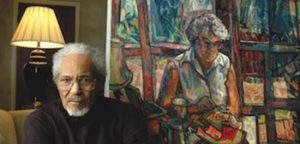
Edward Loper Sr.
*Edward L. Loper, Sr. was born on this date in 1916. He was a Black artist and teacher.
Edward Lionel Loper Sr. was born to a poor family on the east side of Wilmington, Delaware, in a racially mixed section called Frogtown. His mother was 16 at the time of his birth. Loper was raised primarily by his maternal grandmother. Growing up, he did not receive formal artistic training. He attended Howard High School as an All-State football and basketball player. At the time, this was the only high school in Delaware that Blacks were allowed to participate in.
After graduating in 1934, he had to forego an athletic scholarship at Lincoln University in Pennsylvania to start working to help his family financially. During the Great Depression, Loper started working in Delaware for the Works Progress Administration (WPA), rendering drawings of decorative art for the Index of American Design, a large archive of folk art images based in Washington, DC. The job required him to illustrate images of objects in American design, such as toys and furniture. He produced 113 of them in total. He later credited the job with giving him his start as an artist.
Three of his renderings (a Windsor chair, a toy bank, and a cast-iron fire screen) were later included in the Index of Modern Design's 2002 exhibition, Drawing on America's Past: Folk Art, Modernism and the Index of American Design. The index is housed at the National Gallery of Art in Washington, DC. Loper was encouraged to paint by his WPA co-worker Walter Pyle, the nephew of illustrator and author Howard Pyle. Loper began studying Howard Pyle's work at the Wilmington Public Library. He started taking the train to the Philadelphia Museum of Art on weekends, studying painting's great masters; self-taught, he slowly developed his style and technique.
The Works Progress Administration Art Project employed him from 1936–41 at the Allied Kid leather tanning factory until 1947, when he became a full-time artist and teacher. In 1937, Loper became the first Black to have a painting accepted by the Wilmington Society of the Fine Arts (now the Delaware Art Museum). His painting After a Shower, a depiction of Wilmington on a stormy night, won an honorable mention at a 1938 exhibition of the Wilmington Society of the Fine Arts and was later purchased by the society for its permanent collection. He was profiled in Alain Locke's 1940 book The Negro in Art.
In 1941, he exhibited a painting at the University of Delaware. At the time, Blacks were not allowed to attend the university. In the 1940s, Loper mainly painted landscapes and cityscapes of his neighborhood in Wilmington in vivid colors. By the early 1950s, with a growing appreciation of the works of Pablo Picasso, Loper had transitioned from creating self-described mood paintings to concentrating on color and shapes, including experimenting with a kind of kaleidoscopic cubism, refracting subjects into planes as if seen through shards of glass. Loper started to teach painting in 1940. Eventually, in the late 1940s, to escape some of the racism he experienced at home, he began traveling to Quebec City in Canada, where he would paint boldly colored cityscapes. He began taking his students there every summer starting in the 1960s.
Over the years, he would teach at the Allied Kid Company, Delaware Art Museum, Delaware College of Art and Design, Lincoln University, Jewish Community Center in Wilmington, and finally, classes at his studio. As a teacher, Loper was known for his charismatic, intense, and demanding demeanor. His artistic direction was solidified in 1963 after he was invited to attend classes at the Barnes Foundation in Merion, Pennsylvania, established home to one of the world's largest private art collections. He was first asked to study there when he met Barnes in 1946 but declined the original offer, as he was recently married with young children to care for.
He was taught by Violette de Mazia to carefully analyze classical techniques at the Barnes Foundation from 1963 to 1968. When he saw Paul Cézanne's The Boy in the Red Vest, it changed the way he thought about color, having a major effect on the use and juxtaposition of color in his work. He was heavily influenced by his study of art at the Barnes Foundation. Loper's work of the 1960s and beyond became more dramatically structured, colorful, and refracted than his earlier work. Loper lived in Wilmington, Delaware, for his entire life. He and his first wife, Viola Virginia Cooper, married in 1935. She died from a ruptured ectopic pregnancy in 1944. They had three children. In 1945, he married Claudine Bruton. They later divorced. He and Janet Neville were married in 1986 and were together for the rest of his life. Loper's son, Edward Loper Jr., is also an accomplished painter.
In 1950, Loper designed and built a three-bedroom ranch house in Wilmington. His family bought the parcel of land for $100 in 1941. In designing the house, he was influenced by Frank Lloyd Wright and Japanese architecture. In the living room, Loper painted a mural of female figures. The garage was converted into a studio, where Loper gave weekly art lessons in his later years. The Delaware Art Museum organized Loper's first retrospective in 1996, Edward L. Loper: From the Prism's Edge, covering 60 years of his work. In 2007, the University of Delaware presented The Art of Edward Loper, Sr.: On the Path of the Masters, a comprehensive retrospective. Edward Loper Sr. from Delaware, best known for his vibrant palette and juxtaposition of color, died on October 11, 2011.